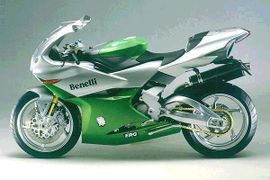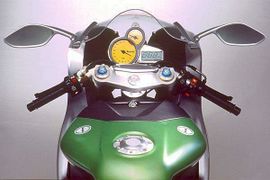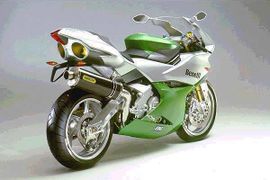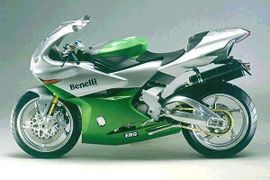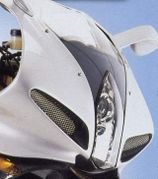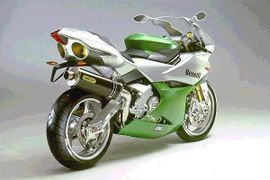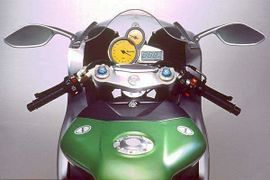Benelli Tre 900S Tornado
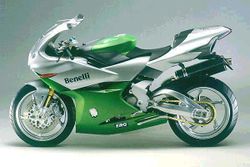 |
|
| Benelli Tre 900S Tornado | |
| Manufacturer | |
|---|---|
| Production | 2000 |
| Class | Sport Bike |
| Engine | liquid-cooled, four-stroke, transverse three cylinder, DOHC, 4 valves per cylinder |
| Bore / Stroke | 83.8mm x 83.8mm |
| Compression ratio | 11.0:1 |
| Horsepower | 140.0 HP (104.4 KW) @ 11500RPM |
| Torque | 70.07 ft/lbs (95.0 Nm) @ 8800RPM |
| Transmission | Gear box: 6-speed, manual Final Drive: chain |
| Frame | Front section in chrome-molybdenum steel tubes,rear section inhollow cast aluminum box section |
| Suspension | Front: 46mm Marzocchi upside-down fork Rear: adjustable mono-shock |
| Brakes | Front: dual 320mm discs, 4-piston calipers Rear: single 240mm disc, 4-piston caliper |
| Front Tire | 120/70-17 |
| Rear Tire | 190/50-17 |
| Wheelbase | 54.88 inches (1394 mm) |
| Seat Height | 31.89 inches (810 mm) |
| Weight | 198.0 kg (wet) |
| Fuel Capacity | 20.5 Liters / 5.4 US gal |
| Manuals | Service Manual |
The Benelli Tre 900S Tornado was a liquid-cooled, four-stroke, transverse three cylinder, DOHC, 4 valves per cylinder Sport Bike motorcycle produced by Benelli in 2000. Max torque was 70.07 ft/lbs (95.0 Nm) @ 8800 RPM. Claimed horsepower was 140.0 HP (104.4 KW) @ 11500 RPM.
Engine[edit | edit source]
A 83.8mm bore x 83.8mm stroke result in a displacement of just 898.0 cubic centimeters.
Drive[edit | edit source]
The bike has a 6-speed, manual transmission. Power was moderated via the wet multi-disc, manual.
Chassis[edit | edit source]
It came with a 120/70-17 front tire and a 190/50-17 rear tire. Stopping was achieved via dual 320mm discs, 4-piston calipers in the front and a single 240mm disc, 4-piston caliper in the rear. The front suspension was a 46mm Marzocchi upside-down fork while the rear was equipped with a adjustable mono-shock. The wheelbase was 54.88 inches (1394 mm) long.
2000 Benelli Tre 900S Tornado[edit | edit source]
The 2000 MY Benelli Tre 900S Tornado sports a liquid-cooled, four-stroke, 898cc, transverse three cylinder engine powerplant mated to a six-speed manual transmission, that can produce a claimed 140 horsepower and 95 Nm of torque.
This sport-bike also boasts standard features such as a 46mm Marzocchi upside-down telescopic fork, an adjustable mono-shock in the rear, dual front disc brakes, an aerodynamic, full-fairing with an adjustable windshield, a single seat, a digital and analogue instrumentation panel, and lightweight, cast-aluminum wheels.
Photos[edit | edit source]
Overview[edit | edit source]
Benelli is a legendary name, with many racing successes in the past, but in recent years, it has been better known for its scooters. The appearance of the Tornado Tre 900 superbike in 1999 changed that. It uses unconventional design philosophies aimed at producing a fast, aerodynamic sportsbike, both for the road and World Superbike championship.
The radiator that cools the engine is mounted under the seat, rather than in front of the engine, and this, together with the narrow three-cylinder engine, gives the Tornado a slim frontal aspect, improving aerodynamics and top speed. The 120° triple engine has a balance shaft for extra smoothness and is mounted in an innovative glued aerospace frame.
It's three long years since the Tornado was
unveiled by the reborn Benelli firm, whose youthful, bike-crazy
boss, Andrea Merloni is from the mega-rich
family that owns Ariston and Indesit. During that time Benelli works racer Peter
Goddard has succeeded in scoring points in World Superbikes, albeit without
getting near the top places, as development of the roadgoing version has
continued.
Enthusiastic punters who clamoured to put their names down for one of the initial, Limited Edition machines back in 1999 have been getting frustrated as the roadster's launch date slipped backwards...
But at last Benelli have finished developing the 12-valve triple, and production at their factory in Pesaro, on Italy's east coast, is under way. Just 150 units of the Tornado Limited Edition are being built, for sale at £22,500 each. (A mass-produced, dual-seat model with the same engine is due in the autumn at roughly half that price.) The specification is mouth-watering: 143bhp from the liquid-cooled engine; a frame that combines steel tubes and aluminum sections at the swing-arm pivot; full carbon-fibre bodywork; and some of the best cycle parts money can buy. The chance of a blast on the Tornado on the roads near Pesaro was too good to miss, and the excitement started even before I'd set eyes on the bike. Sitting in the reception area of Benelli's modern factory on the outskirts of town, I was suddenly aware of an improbably loud and utterly distinctive exhaust note, as Benelli's test rider Gianluca alasso pulled up outside on the Tornado, and gave its throttle a few not-strictly-necessary blips for good effect. Outside in the sunshine, the triple, finished in Benelli's traditional green-and-silver color scheme (the firm has a rich racing history, and won the 250cc world championship in 1969 through Aussie Kel Carruthers), looked as gorgeous as I'd expected. Morton's design has changed subtly since the bike was unveiled, but the Tornado still manages to be very distinctive as well as stylish, with its intricate curves, and two small headlights between slanted intake slots in its nose. This Limited Edition version is one of the classiest streetbikes in existence, containing heaps of high-quality engineering. Its steel and aluminum frame sections are glued together in aircraft style, as well as bolted. Its steering geometry and the position of its big aluminum swing-arm can be fine-tuned, in GP racer fashion. Its front and rear suspension is from Öhlins; wheels are lightweight forged jobs from Marchesini.
That all means this Tornado roadster is arguably closer than any of its rivals to its namesake on the World Superbike grid. And it felt that way as I settled myself into the saddle (which is tall due to the air ducts running below it to the radiator), fired up the 898cc engine, prodded into gear and headed off with the three-into-one exhaust's race can making a tuneful three-cylinder warble. The triple also comes with a street-legal silencer, plus other goodies including alternative sprockets and a cover. The bike's raw, race-ready feel was one of its best features, but it wasn't all good news. The Tornado idled okay but below 4000rpm it spluttered and refused to run properly, before clearing to give a pleasantly linear response through the midrange. On the fairly empty Italian roads that didn't cause much trouble, but this Tornado wouldn't have been much fun in city traffic. YOU IN THE RAC MATE? Provided I made sure there was five grand or more showing on the yellow tacho, all was well. The Benelli stormed forward enthusiastically, kicking harder as the needle approached the 11,500rpm red-line. The six-speed gearbox was slick, and the triple seemed pretty smooth, too. But later on the autostrada, when I had the chance to put some serious numbers on the digital speedo, there was more vibration than I'd expected - due, Benelli later said, to a key linking the balancer-shaft to the crank being out of tolerance. The buzz though the bars and pegs wasn't a big problem as kept my head down behind the screen on the near-empty autostrada, and wound the Tornado to a rock-solid indicated 150mph, a little short of its likely top speed of close to 170mph. Then the engine suddenly died completely, due to a failure of the engine management black box. Along with the poor low-rev running, it was enough to convince me that Benelli had plenty more work to do to get the injection system sorted. That problem was a disappointment because in most respects the Tornado had impressed. Its chassis is outstanding, combining the frame's rigidity and the flawless control of the firm Öhlins units with the vast amount of track-day tweaking potential. On the mainly tight and twisty hill roads near Pesaro the Benelli handled brilliantly on its standard settings, giving huge amounts of feedback yet also managing to float over most road imperfections. At 185kg dry the triple is light, and it steered very easily while staying impressively stable, both in turns and under hard acceleration. There was heaps of Ground Clearance, and fat sticky Pirelli Dragon Supercorsas to make good use of it. Brembo's brake set-up with four-piston, four-pad calipers has become almost obligatory on exotic Italian bikes of late, and delivers so much stopping power and lever feel that it's easy to understand why. For most of my day's ride the Tornado was so quick, agile and full of character that I had a brilliant time riding it, and ended up back on it that evening (after the faulty black box had been replaced) with my initial high regard for the triple dented but still intact. Whether I'd have been happy if I'd just paid £22,500 for a bike with this one's rough edges is another matter, though. Benelli insist they have improved the low-rev injection glitch, and that the failure won't happen on production machines. The enthusiasts who will soon be taking delivery of their long-awaited Tornados will be hoping that they're right. Source insidebikes.com
Specifications[edit | edit source]
| Make Model | Benelli Tre 900S Tornado |
|---|---|
| Year | 2000 |
| Engine Type | Four stroke, transverse three cylinder, DOHC, 4 valves per cylinder |
| Displacement | 898 cc / 54.8 cu in |
| Bore X Stroke | 85.3 x 52.4 mm mm |
| Compression | 11.0:1 |
| Cooling System | Liquid cooled |
| Lubrication | Wet sump |
| Induction | Sagem, electronic ignition with 1 injector for each cylinder |
| Ignition | Electronic ignition |
| Starting | Electric |
| Max Power | 104.4 kW / 140 hp @ 11500 rpm |
| Max Torque | 95 Nm / 9.69 kgf-m / 70.1 lb-ft @ 8800 rpm |
| Clutch | Wet, multiplate with anti-blocking system |
| Transmission | 6 Speed |
| Final Drive | Chain |
| Frame | Front section in chrome-molybdenum steel tubes,rear section inhollow cast aluminum box section |
| Front Suspension | Upside down Marzocchi, 46 mm Ø, adjustable Ferderbasis, course and compression phase absorption |
| Rear Suspension | Central shock strut with lever system, adjustable feather/spring basis, course and compression phase absorption |
| Front Brakes | 2 x 320 mm Ø discs, 4 piston calipers |
| Rear Brakes | Single 240 mm Ø disc, 4 piston caliper |
| Front Wheel | 3.5 x 17 in |
| Front Tire | 120/70-17 |
| Rear Wheel | 6.0 x 17 in |
| Rear Tire | 190/50-17 |
| Wheelbase | 1395 mm / 54.9 in |
| Seat Height | 810 mm / 31.9 in |
| Dry Weight | 198 kg / 437 lbs |
| Fuel Capacity | 20.5 Liters / 5.4 US gal |
| Review | Insidebikes |
